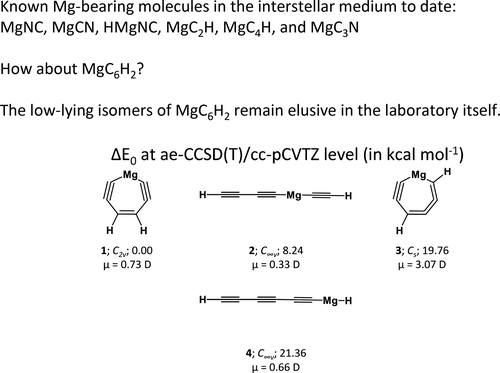当前位置:
X-MOL 学术
›
J. Phys. Chem. A
›
论文详情
Our official English website, www.x-mol.net, welcomes your
feedback! (Note: you will need to create a separate account there.)
MgC6H2 Isomers: Potential Candidates for Laboratory and Radioastronomical Studies.
The Journal of Physical Chemistry A ( IF 2.7 ) Pub Date : 2020-08-17 , DOI: 10.1021/acs.jpca.0c06401 Aditya P Pandey 1, 2 , Uday Kumar Padidela 2 , Loganathan Konda Thulasiraman 3 , Ramakrishnan Sethu 4 , Pothiappan Vairaprakash 5 , Venkatesan S Thimmakondu 6
The Journal of Physical Chemistry A ( IF 2.7 ) Pub Date : 2020-08-17 , DOI: 10.1021/acs.jpca.0c06401 Aditya P Pandey 1, 2 , Uday Kumar Padidela 2 , Loganathan Konda Thulasiraman 3 , Ramakrishnan Sethu 4 , Pothiappan Vairaprakash 5 , Venkatesan S Thimmakondu 6
Affiliation

|
Eighty three stationary points of MgC6H2 isomers spanning from 0 to 215 kcal mol–1 have been theoretically identified using density functional theory at the B3LYP/6-311++G(2d,2p) level of theory. Among them, four low-lying isomers lying within 23.06 kcal mol–1 (1 eV) have been further characterized in detail using high-level coupled-cluster (CC) methods. The thermodynamically most stable isomer turns out to be 1-magnesacyclohepta-4-en-2,6-diyne (1). The other three isomers, 3-magnesahepta-1,4,6-triyne (2), 1-magnesacyclohepta-2,3,4-trien-6-yne (3), and 1-magnesahepta-2,4,6-triyne (4) lie 8.24, 19.76, and 21.36 kcal mol–1, respectively, above 1 at the ae-CCSD(T)/cc-pCVTZ level of theory. All the four isomers are polar with a permanent electric dipole moment (μ ≠ 0). Hence, they are potential candidates for rotational spectroscopic studies. Considering the recent identification of magnesium-bearing hydrocarbons such as, MgC2H and MgC4H in IRC+10216, it is believed that the current theoretical data may be of relevance to laboratory molecular spectroscopic and radioastronomical studies on MgC6H2 isomers. The energetic and spectroscopic information gathered in this study would aid the detection of low-lying MgC6H2 isomers in the laboratory, which are indispensable for radioastronomical studies. It is also noted here that neither the National Institute of Standards and Technology Chemistry WebBook nor the Kinetic Database for Astrochemistry lists any isomer of MgC6H2 at the moment. Therefore, these isomers are studied here theoretically for the very first time.
中文翻译:

MgC6H2异构体:实验室和放射天文研究的潜在候选对象。
使用密度泛函理论在B3LYP / 6-311 ++ G(2d,2p)的理论水平上,理论上确定了范围从0到215 kcal mol –1的MgC 6 H 2异构体的83个固定点。其中,使用高级偶联簇(CC)方法对位于23.06 kcal mol –1(1 eV)范围内的四个低洼异构体进行了详细的表征。热力学上最稳定的异构体被证明是1-magnesacyclohepta-4-en-2,6-diyne(1)。其他三种异构体,3-magnesahepta-1,4,6-triyne(2),1-magnesacyclohepta-2,3,4-trien-6 -yne (3)和1-magnesahepta-2,4,6-三炔(4)位于8.24、19.76和21.36 kcal mol在ae-CCSD(T)/ cc-pCVTZ理论水平上分别为–1和1以上。所有四种异构体都是极性的,具有永久的电偶极矩(μ≠0)。因此,它们是旋转光谱研究的潜在候选者。考虑到最近在IRC + 10216中鉴定了含镁碳氢化合物(例如MgC 2 H和MgC 4 H),据信当前的理论数据可能与MgC 6 H 2异构体的实验室分子光谱和放射天文研究有关。这项研究中收集的能量和光谱信息将有助于检测低洼MgC 6 H 2实验室中不可缺少的异构体,这对于放射天文研究是必不可少的。在此还应注意的是,目前美国国家标准与技术化学研究所的WebBook或天体化学动力学数据库都未列出MgC 6 H 2的任何异构体。因此,这些异构体在这里是理论上第一次研究。
更新日期:2020-09-18
中文翻译:

MgC6H2异构体:实验室和放射天文研究的潜在候选对象。
使用密度泛函理论在B3LYP / 6-311 ++ G(2d,2p)的理论水平上,理论上确定了范围从0到215 kcal mol –1的MgC 6 H 2异构体的83个固定点。其中,使用高级偶联簇(CC)方法对位于23.06 kcal mol –1(1 eV)范围内的四个低洼异构体进行了详细的表征。热力学上最稳定的异构体被证明是1-magnesacyclohepta-4-en-2,6-diyne(1)。其他三种异构体,3-magnesahepta-1,4,6-triyne(2),1-magnesacyclohepta-2,3,4-trien-6 -yne (3)和1-magnesahepta-2,4,6-三炔(4)位于8.24、19.76和21.36 kcal mol在ae-CCSD(T)/ cc-pCVTZ理论水平上分别为–1和1以上。所有四种异构体都是极性的,具有永久的电偶极矩(μ≠0)。因此,它们是旋转光谱研究的潜在候选者。考虑到最近在IRC + 10216中鉴定了含镁碳氢化合物(例如MgC 2 H和MgC 4 H),据信当前的理论数据可能与MgC 6 H 2异构体的实验室分子光谱和放射天文研究有关。这项研究中收集的能量和光谱信息将有助于检测低洼MgC 6 H 2实验室中不可缺少的异构体,这对于放射天文研究是必不可少的。在此还应注意的是,目前美国国家标准与技术化学研究所的WebBook或天体化学动力学数据库都未列出MgC 6 H 2的任何异构体。因此,这些异构体在这里是理论上第一次研究。











































 京公网安备 11010802027423号
京公网安备 11010802027423号